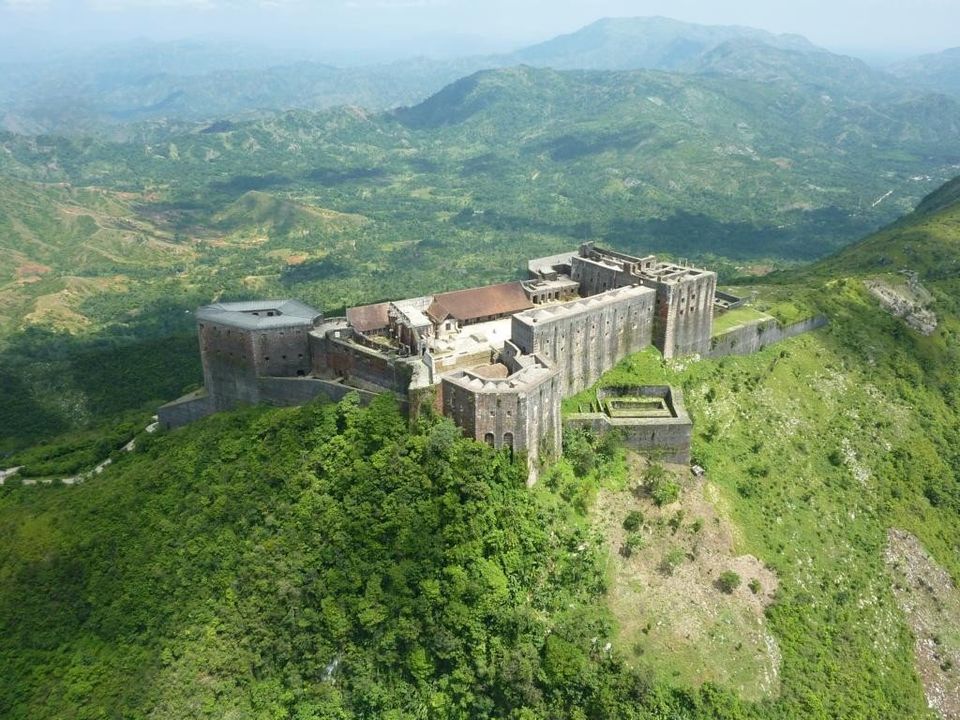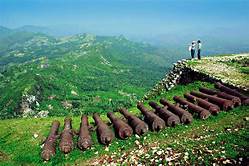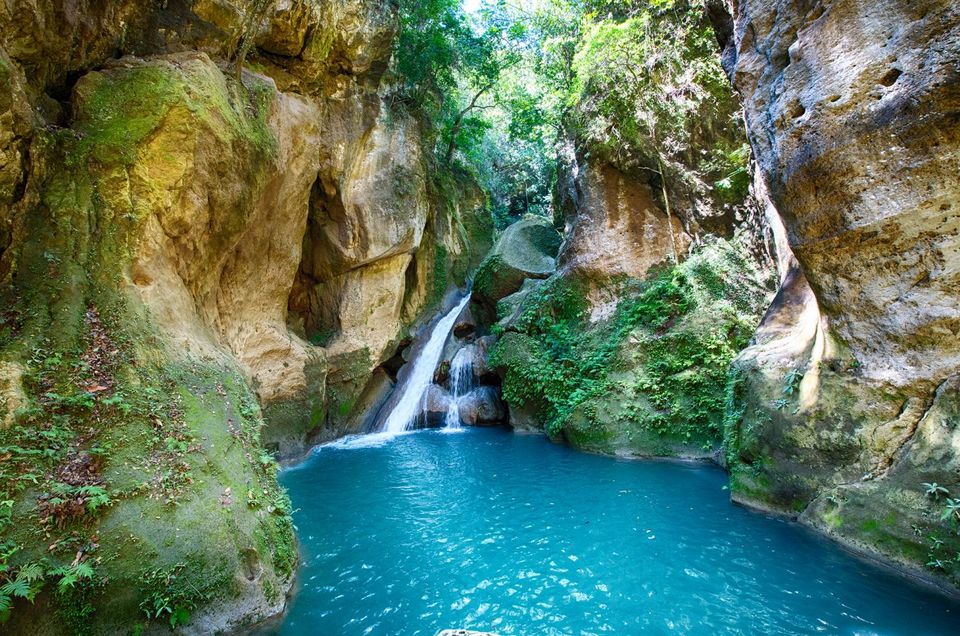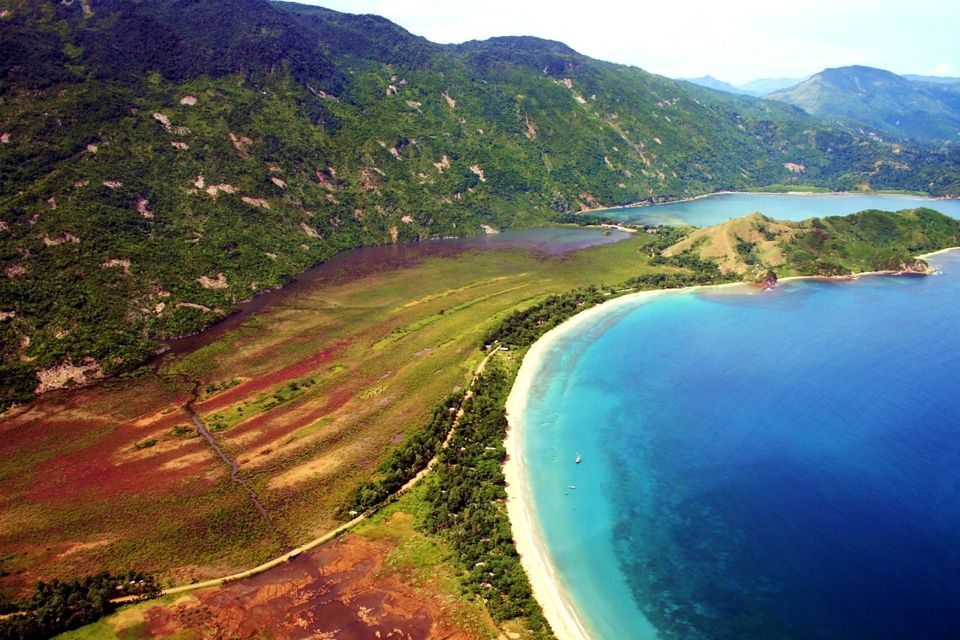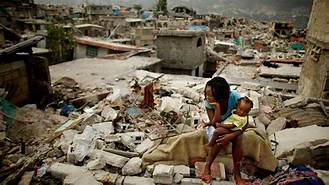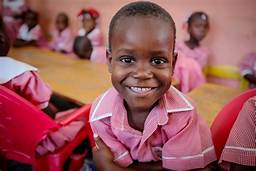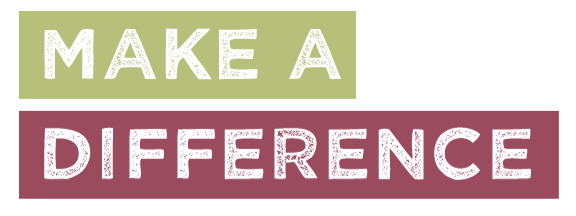About Haiti
Haiti is a Caribbean country that shares the island of Hispaniola with the Dominican Republic to its east. Though it’s still recovering from a 2010 earthquake, many of Haiti's landmarks dating to the early 19th century remain intact. These include Citadelle la Ferrière, a mountaintop fortress, and the nearby ruins of Sans-Souci Palace, the baroque former royal home of King Henry I.
Capital: Port-au-Prince
Founded: January 1, 1804
Population: 10.32 million (2013) World Bank
Currency: Haitian gourde
Official languages: French, Haitian Creole French
Haitian Economy
Haiti’s economy is still recovering from the massive earthquake in January 2010. Its purchasing power parity GDP fell 8% in 2010 (from $12.15 billion to $11.18 billion) and the GDP per capita remained unchanged at (PPP US$) 1,200. Comparative social and economic indicators show Haiti falling behind other low-income developing countries (particularly in the hemisphere) since the 1980s. Haiti ranked 145 of 182 countries in the 2010 United Nations Human Development Index, with 57.3% of the population being deprived in at least three of the HDI’s poverty measures The World Factbook reports a shortage of skilled labor, widespread unemployment and underemployment, saying “more than two-thirds of the labor force do not have formal jobs”, and describes pre-earthquake Haiti as “already the poorest country in the Western Hemisphere with 80% of the population living under the poverty line and 54% in abject poverty.” Most Haitians live on $2 or less per day.
Adult literacy is variously reported as 52.9% [World Factbook] and 65.3% [United Nations], and the World Bank estimates that in 2004 over 80% of college graduates from Haiti were living abroad, with their remittances home representing 52.7% of Haiti’s GDP. Cite Soleil is considered one of the worst slums in the Americas, most of its 500,000 residents live in extreme poverty. Poverty has forced at least 225,000 Haitian children to work as restavecs (unpaid household servants); the United Nations considers this to be a modern-day form of slavery.
HISTORY AND THINGS THAT YOU SHOULD KNOW ABOUT HAITI
Native Haitians were pre-Columbian Ameridian named Taino/Arawak both meaning the good people The Taino/Arawak named their land Haiti, meaning Land of High Mountains.In less than 40 years, Spanish invaders were responsible for the genocide of the 3 millions Haitian natives due to Haiti is the most mountainous country in the Caribbean.
Haiti has the second longest coastline in the Caribbean after Cuba; 1.100 miles. Over 70% of its beaches are still virgin For 4 centuries, 15th -19th century, the world's top 3 major super powers were in war with each other to have control of Haiti for its geographical position. Spain, France and England Haiti was the second country in the world to issue a Declaration of Independence, only 33 years after the United States of America The first and only country in the history of mankind whose independence is the result of a successful slave rebellion.Haiti is the first Black Republic in the World The first country in the Western Hemisphere to have abolished slavery; it would take the United States of America another 65 years to follow suit The first and only Black Nation to have successfully defeated a major world power in a war; under the command of Jean Jacques Dessalines, Haiti defeated the worlds mightiest army at the time France's; on November 18th 1803 after 14 years of battle.-The only country in the Western Hemisphere to have defeated three colonial armies for its independence. The powerful armies of Spain, England and France Haiti is unique in history, going directly from slavery to nationhood. The Independence of Bolivia, Columbia, Ecuador, Peru and Venezuela was a result of direct monetary and military help from Haiti to Simon Bolivar, the greatest Hispanic military leader of all time.Simon Bolivar asked then Haiti's President, Alexandre Petion, to be named the founding father of Venezuela and South America for the help he provided him to fight against slavery in the South American continent; President Petion declined the honor and asked Simon Bolivar in return for , only the total eradication of slavery " Wherever your arms have triumphed".-The National flag of Venezuela was created at the sea port of Jacmel, a city in south east Haiti. Simon Bolivar included the blue and red from the Haitian Flag, as part of the new colors of Venezuela's national symbol in honor of Haiti being the first country in the world to fully eradicate slavery on its soil By winning the Vertieres Battle on November 18th 1803, Haiti forced France to sell to the US, it's Louisiana territory, doubling the size of the United States of America. The Louisiana territory today makes up today 15 US states and part of Canada. Namely, the US states of Arkansas, Missouri, Iowa, Oklahoma, Kansas and Nebraska; part of Minnesota, North Dakota and most of South Dakota, northeastern New Mexico, northern Texas, portions of Montana, Wyoming, Colorado, all Louisiana and, land that will eventually become part of the current Canadian Provinces of Alberta and Saskatchewan
-Upon Independence, Haiti became the first country in the American Continent to constitutionally grant all of iIts citizen full rights, regardless of gender or race.-Haiti occupied the Dominican Republic for 22 years. From 1822 to 1844, holding the entire Island of Hispaniola under iIts jurisdiction. Today's Dominican Republic was called Spanish Haiti at the time Haiti is one of the only two countries in the American Continent having French as an official language. The other is Canada.
Haiti is the only country in the world with Vodou as an official religion Cattle/cow were first introduced in the Americas, in Ile-a-Vache (cow island), a small Island off Haiti's southern coast by the Spanish.For over a century, the livelihood of as many as 25 million inhabitants of France, directly depended on the colonial trade centered in Haiti supplied France for over half the wealth it derived from all its other colonies combined in the 18th century For 105 years (1697-1802) Haiti was responsible for 40% of the sugar consumed in the entire world; 123 millions pounds in 1788 alone.For much of the 17th and the 18th century, Haiti was responsible for 60% of the world's coffee exports On December 5th 1803, the exact day of the 311 years anniversary of when the first European sat foot on Haiti's soil, Jean Jacques Dessalines, the country fat Haiti is the only country in the world with Vodou as an official religionCattle/ cow were first introduced in the Americas, in Ile-a-Vache (cow island), a small Island off Haiti's southern coast by the Spanish.For over a century, the livelihood of as many as 25 million inhabitants of France, directly depended on the colonial trade centered in Haiti supplied France for over half the wealth it derived from all its other colonies combined in the 18th century For 105 years (1697-1802) Haiti was responsible for 40% of the sugar consumed in the entire world; 123 millions pounds in 1788 alone.For much of the 17th and the 18th century, Haiti was responsible for 60% of the world's coffee exports On December 5th 1803, the exact day of the 311 years anniversary of when the first European sat foot on Haiti's soil,
Facts about Haiti
•
Haiti is for many the poorest country in the Americas as per the Human Development Index. It has experienced political violence throughout its history.
• The country’s highest point is Pic la Selle, at 8,793 feet. The total area of Haiti is 10,714 square miles with a population of 10,032,619(2) and its capital is Port-au-Prince. Haitian Creole and French are the official languages.
•
Haiti’s regional, historical, and ethno-linguistic position is unique for several reasons. It was the first independent nation in Latin America and the first black-led republic in the world when it gained independence as part of a successful slave revolution in 1804. Despite having common cultural links with its Hispano-Caribbean neighbors, Haiti is the only predominantly Francophone independent nation in the Americas. It is one of only two independent nations in the Americas (along with
Canada) that designate French as an official language; the other French-speaking areas are all overseas departments, or collectivités, of France.
2010 earthquake in Haiti
On January 12, 2010, at 21:53 UTC, (4:53 pm local time) Haiti was struck by a magnitude-7.0 earthquake, the country’s most severe earthquake in over 200 years. The epicenter of the quake was just outside the Haitian capital Port-au-Prince. On 10 February the Haitian government gave a confirmed death toll of 230,000. Widespread damage resulted from the quake. The capital city was devastated.
The Presidential Palace was badly damaged, with the second floor entirely collapsing onto the first floor; the HaitanHaitian Parliament building, UN mission headquarters and the National Cathedral were also destroyed. International aid flowed in but was hampered by damaged infrastructure: the main port was damaged beyond immediate use, the one local airport was of limited capacity and border crossings with the Dominican Republic were distant and crowded. As many as one million Haitians were left homeless.
Haiti will need to be completely rebuilt from the ground up, according to a journalist, as “E[e]ven in good times, Haiti is an economic wreck, balancing precariously on the razor’s edge of calamity”. Several international appeals were launched within days of the earthquake, including the Disasters in the United Kingdom, Young Artists for Haiti (Canada) and Hope of Haiti Now: A Global Benefit for Earthquake Relief based in the USA, which was a global effort to raise relief funds by way of a charity telethon held on January 22, 2010. International officials are looking at the short and long term priorities while continuing the daily task of managing the emergency situation. As of September 2010, there were over one million refugees living in tents and the humanitarian situation has been characterized as still being in the emergency phase
• The educational system of Haiti is based on the French System. Higher education, under the responsibility of the Ministry of Education, is provided by universities and other public and private institutions. Haiti counts 15,200 primary schools, of which 90% are non-public and managed by communities, religious organizations or NGOs. The enrollment rate for primary school is 67%, and fewer than 30% reach 6th grade. Secondary schools enroll 20% of eligible-age children. Charity organizations, such as Sionfonds for Haiti, are building schools for children and providing necessary school supplies. Haiti’s literacy rate is 52.9%.
• The January earthquake was a major setback for education reform in Haiti. Literacy levels continue to hover around 50 percent. Haiti is one of the lowest-ranked countries in the world, 177th out of 186, for national spending on education.
• Many reformers have advocated the creation of a free, public and universal education system for all primary school-age students in Haiti. The Inter-American Development Bank estimates that the government will need at least $3 billion USD to create an adequately funded system.
Why Haiti?
We are confident Haiti is not the only places or country in this world that is in need right now. We are all able to see the that poverty, lack of infrastructure, kids in need, and more so on are a worldwide issue. We all need to start somewhere. We choose Haiti for many reasons: 1) That is where we are from 2) Haiti is the closest to the worlds greatest country 3) Haiti is the poorest country in the west hemisphere 4) Haiti has a great history that cannot be forgotten 5) Haiti has helped many countries to gain their freedom 6) Haiti can come out if we do what should be done 7) Haiti has a lot ofmore strength than many believe. 8) Haiti is in great need and any even small a little help can do a lot.
The Good part about Haiti
Haiti is coming out of the shadows and is still a viable choice for a Caribbean vacation. If you visit Haiti, you will be impressed with the enthusiasm and friendliness of the people, intrigued by the French Creole history and culture, and absolutely knocked out by the quality and affordability of locally produced works of art.Haiti still has some rough edges, so we recommend making arrangements with a trusted local tour operator. Haitian people have a sense of humor, and will definitely make your stay an unforgotten unforgettable memory. You will be surprise to see the huge difference between what the media said says and what the actual life is like. You will be surprised that the country is far away more peaceful than many other places across the world, including the USA. You will be surprised that you will fall in love of with this country by seeing the courage, the strength and the welcome of those the Haitian people Here's why a trip to Haiti is worth the effort.
Here's why a trip to Haiti is worth the effort.
Shop at Noailles the Iron Crafts Town
One of Haiti's most arresting interesting artistic products is its metal sculpture, with much of it being created from used metal drums. The village of Noailles, in the Croix des Bouquets area, is famous for the quality of its artwork and abundance of shops. The variety of work is amazing and the prices are low, with bargaining accepted. Many of the pieces are small enough to fit in a suitcase, making it easy to bring purchases home
Hike to Bassin-Bleu Waterfall
The Bassin-Bleu waterfall can be reached from the town of Jacmel, in Haiti's southeastern region. It's best to arrange the services of a guide, who can lead travelers to Bassin-Bleu, where they can cavort in the falls. Only a limited number of visitors are allowed to the falls each day, so it's important to make arrangements in advance
Tasting at Rhum Barbancourt
Sugarcane and rum are an integral part of Haiti's heritage. A really pleasant way to get a history lesson is to take a tour of the Rhum Barbancourt distillery, which produces award-winning rum from the family recipe. The distillery, – which utilizes a unique cognac-based production process, is within easy reach of Port-au-Prince. The tour concludes with an elegant al fresco rum tasting.
A Sunday of worship in Haiti
Absolutely Tthe place to be on a Sunday in Haiti is a Church. Despite anything, the Haitian people worship God with all their heart. You may choose other alternatives on a Sunday if you are not a Christian, but the fact that people still believe in God in such a country is like a miracle. Churches, big and small are all over. All types of denomination are calling on God
Browse the Iron Market
Port-au-Prince's Iron Market has been a pulse point of the city for over a century. Recently renovated and restored, it presents a fascinating look at Haitian life, through its displays of goods, produce and artwork. Vendors are not annoyingly insistent and the presence of special tourist police keeps things fine and mellow.
Catch the View at L'Observatoire
Whether arriving at L'Observatoire for a late breakfast or an evening meal or cocktail, the mountaintop view of Port-au-Prince and the surrounding countryside and sea is stupendous. The al fresco restaurant serves Haitian specialties (try the accra, delicious Haitian fritters). It can get chilly in the evening, so bring along a sweater.
Visit Musee Ogier-Fombrun
Travelers can combine a beach vacation with a visit to Musee Ogier-Fombrun, a history museum on Haiti's Arcadins Coast. The museum's collection is housed in a restored sugarcane plantation house dating back to 1760. The exhibits paint a stirring picture of Haiti's heritage, ranging from the country's sugarcane industry to the 18th century slave rebellion.
Climb to Citadelle Laferriére
Citadelle Laferriére is a mountaintop 19th century fort in the northern part of Haiti, about 17 miles from the city of Cap Haitien. While the view from the fort's battlements is inspiring, the story behind the fort is even more remarkable. Citadelle Laferriére was built by former slaves, who won their freedom in Haiti's slave revolt of 1804. It takes an effort to reach the fort along a 4.3 mile trail and most visitors approach via horseback, making the experience even more evocative of times gone by.
Tour Sans-Souci Palace
Sans-Souci Palace was the residence of Haiti's black king, Henri Christophe, a leader in the country's slave rebellion. Located in the town of Milot, the palace was completed in 1813 and was at one time one of the most magnificent buildings in the West Indies. Many travelers combine a visit to Sans-Souci Palace with a tour of Citadelle Laferriére
Hit the Beach at Port Salut
Haiti is ringed by first-rate beaches. One of the finest is at Port-Salut, on Haiti's southern shore. The half-mile long beach is bordered by swaying palms and is often secluded, making it a great choice for couples. There are a few hotels and restaurants, but mostly this is Haiti at its most laidback.


